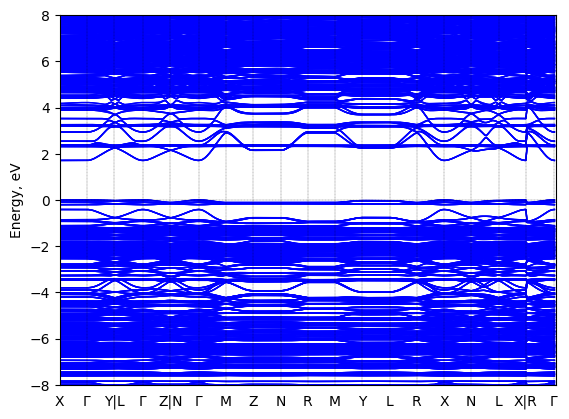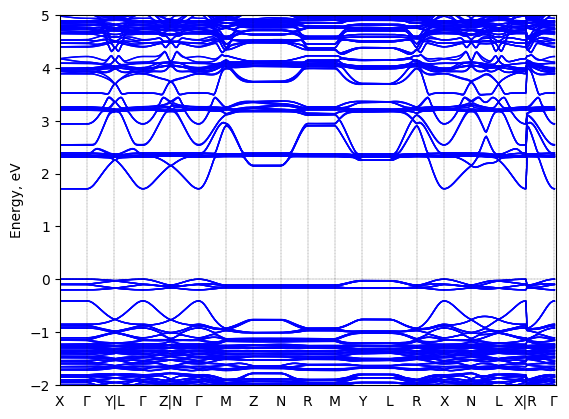5,5'''-bis(aminoethyl)-2,2':5',2'':5'',2'''-quaterthiophene lead iodide
Chemical Formula: C20H22N2S4PbI4
IUPAC: 5,5'''-bis(aminoethyl)-2,2':5',2'':5'',2'''-quaterthiophene lead(II) iodide
Alternate Names: 5,5'''-bis(aminoethyl)-2,2':5',2'':5'',2'''-quaterthiophene tetraiodoplumbate(II), AE4TPbI4, (AEQT)PbI4, AEQTPbI4, C20H22S4N2PbI4
Organic: C20H22N2S4
Inorganic: PbI4, Lead iodide
Dimensionality: 2D n: 1
Formal Stoichiometry:
C : 20
,
H : 22
,
N : 2
,
S : 4
,
Pb : 1
,
I : 4
Atomic structure Verified
See all entries for this property (3 total)
Origin: computational
Crystal system: triclinic
| a: | 39.01481456 Å |
| b: | 12.09647627 Å |
| c: | 12.22481263 Å |
| α: | 90.0346079° |
| β: | 91.076978° |
| γ: | 90.03861881° |
Sample type: single crystal
Code: FHI-aims
Level of theory: density functional theory
Exchange-correlation functional: HSE06 α = 0.25, ω = 0.11/bohr
Level of relativity: with spin-orbit coupling
Comment: Using the experimental structure of AE4TPbBr4 [1], also in Dataset ID 217. Replace the Br atoms with I. Refer to SI Part IX for more details. [1] D. B. Mitzi, K. Chondroudis, and C. R. Kagan, Inorg. Chem. 38, 6246 (1999).
Entry added on: April 15, 2019, 9:54 p.m.
Entry added by: Xiaochen Du Duke University
Last updated on: Aug. 11, 2019, 4:54 p.m.
Last updated by: Xiaochen Du Duke University
Data correctness verified by:
- Rayan C Duke University
Download data
Band structure
See all entries for this property (2 total)
Theory then geometry optimized; all-anti-AE4TPbI4
Origin: computational
Crystal system:


Sample type: single crystal
Code: FHI-aims
Level of theory: density functional theory
Exchange-correlation functional: HSE06 α = 0.25, ω = 0.11/bohr
K-point grid: 3x3x3
Level of relativity: atomic ZORA with spin-orbit coupling
Basis set definition: tight
Entry added on: May 8, 2019, 5:39 p.m.
Entry added by: Raul Laasner Duke University
Last updated on: May 8, 2019, 5:39 p.m.
Last updated by: Raul Laasner Duke University
Download data
Absorption spectrum Verified
See all entries for this property (2 total)
Origin: experimental (T = 298.0 K)
Sample type: film
Starting materials: AE4T*2HI, PbI2
Product: AE4TPbI4 film on glass or quartz
Description: Thin film growth by RIR-MAPLE method from a 4 mM solution of the precursor salts using a 1:1 vol:vol blend of DMSO and ethylene glycol as the solvent. Films are annealed in nitrogen at 200 C for 30 min after deposition.
Method: UV-vis absorption
Description: UV-vis spectra were collected using a Shimadzu UV-3600 spectrophotometer using a blank substrate as reference.
Entry added on: June 7, 2019, 12:37 a.m.
Entry added by: Wiley Dunlap-Shohl University of Washington
Last updated on: April 9, 2022, 3:41 p.m.
Last updated by: Rayan C Duke University
Data correctness verified by:
- Rayan C Duke University
Download data
Photoluminescence Verified
See all entries for this property (2 total)
Origin: experimental (T = 298.0 K)
Sample type: film
Starting materials: AE4T*2HI, PbI2
Product: AE2TPbI4 film on glass or quartz
Description: Thin film growth by RIR-MAPLE method from a 8 mM solution of the precursor salts using a 1:1 vol:vol blend of DMSO and ethylene glycol as the solvent. Films are annealed in nitrogen at 150 C for 10 min after deposition.
Method: Photoluminescence
Description: Steady-state PL spectra were recorded using Edinburgh Instruments FS920 fluorimeter that was equipped with a 450 W xenon arc lamp as the excitation source, and a Peltier-cooled Hamamatsu R2658P photomultiplier tube.
Entry added on: June 7, 2019, 12:44 a.m.
Entry added by: Wiley Dunlap-Shohl University of Washington
Last updated on: April 9, 2022, 3:47 p.m.
Last updated by: Rayan C Duke University
Data correctness verified by:
- Rayan C Duke University
Download data
Photoluminescence excitation Verified
Origin: experimental (T = 298.0 K)
Sample type: film
Starting materials: (AEQT)PbI4, quartz, acetone, ethanol
Product: (AEQT)PbI4 thin film. Film thickness between 500 Å and 900 Å.
Description: To prepare (AEQT)PbI4, sonicate quartz samples in 2% (w/v) detergent solution in water (20 min), then sonicate in acetone (20 min) and ethanol (20 min). Boil in ethanol (5 min) and place in a 130 °C oven to dry. Add 0.003 g of (AEQT)PbI4 compounds to 0.1 mL of methanol, and sonicate again for 10 min. Place the charge dropwise via a syringe on the tantalum heater of the SSTA chamber. Close chamber and evacuate all solvent with a rotary mechanical pump. Switch on a turbomolecular pump, and pump system to approximately 10^{-7} Torr. To initiate the evaporation, pass a large current of approximately 65 A through the heater for about 4 s. Anneal the (AEQT)PbI4 films at 200 °C for 30 min.
Comment: Single source thermal ablation (SSTA) technique.
Method: Spectrofluorometer
Description: Photoluminescence excitation (PLE) spectra was recorded at room temperature on a Spex Fluorolog-2 spectrofluorometer using the front-face geometry. Light from a xenon arc lamp was used as the excitation source, after being passed through a SPEX 1680 0.22 m double monochromator. The wavelength was 540 nm.
Comment: Refer to Figure 9.
Entry added on: May 14, 2020, 11:27 a.m.
Entry added by: Xiaochen Du Duke University
Last updated on: April 1, 2022, 4:41 p.m.
Last updated by: Rayan C Duke University
Data correctness verified by:
- Rayan C Duke University
Download data
Band structure Verified
See all entries for this property (2 total)
Experimental then geometry optimized
Origin: computational
Crystal system: unknown


Sample type: single crystal
Code: FHI-aims
Level of theory: density functional theory
Exchange-correlation functional: HSE06 α = 0.25, ω = 0.11/bohr
K-point grid: 3x3x3
Level of relativity: atomic ZORA with spin-orbit coupling
Basis set definition: tight
Entry added on: July 21, 2020, 6:23 p.m.
Entry added by: Xiaochen Du Duke University
Last updated on: July 21, 2020, 6:23 p.m.
Last updated by: Xiaochen Du Duke University
Data correctness verified by:
- Rayan C Duke University
Download data